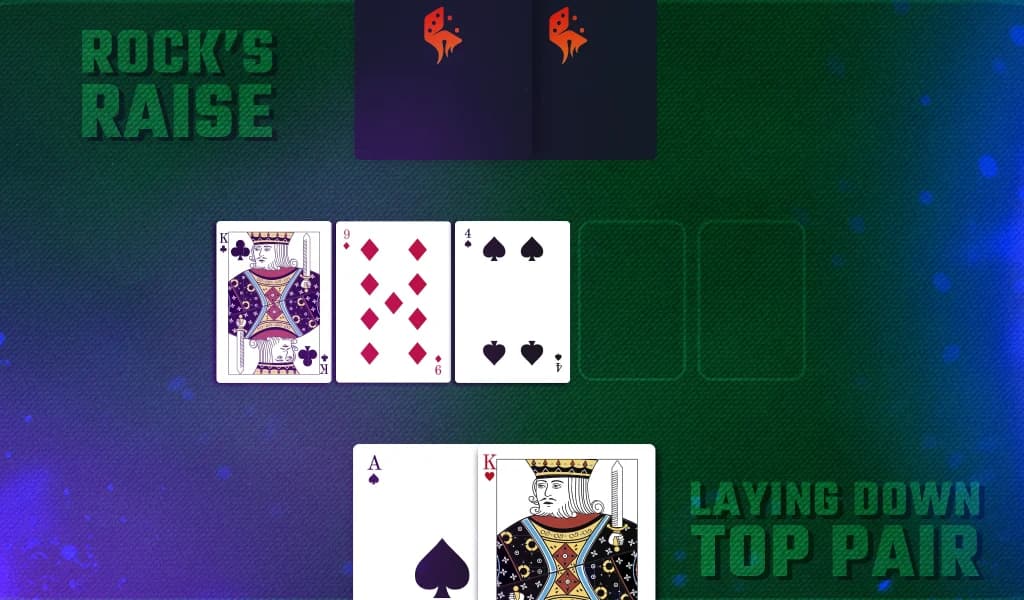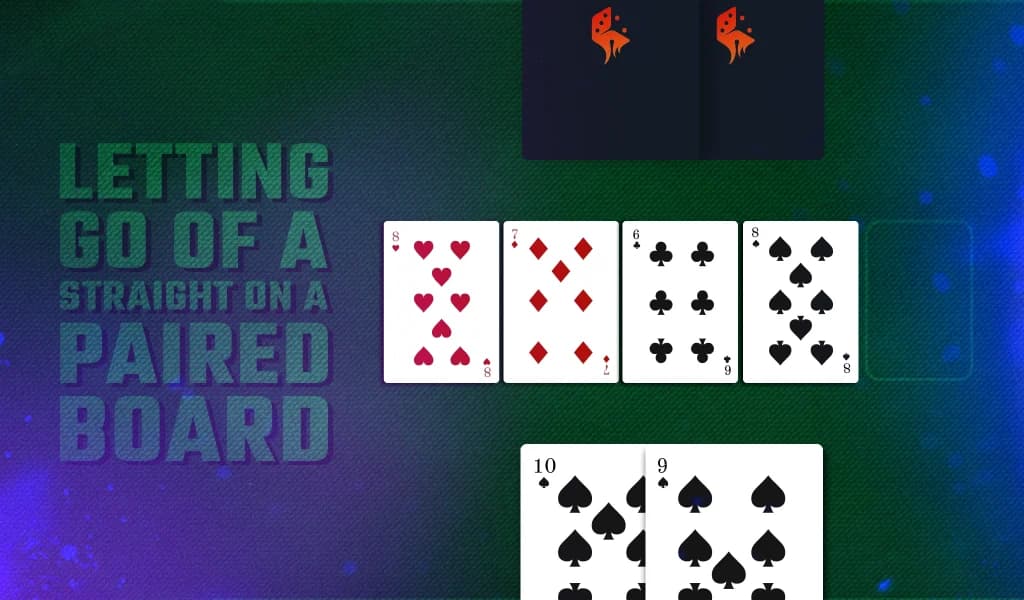
As Kenny Rogers (may he rest in peace) famously sang in The Gambler, “You’ve got to know when to hold ‘em, know when to fold ‘em…” The problem is, it isn’t always clear which is the right course of action in a game of online poker. But all players who master the art of the laydown can protect their bankrolls and preserve all those hard-earned winnings.
Scenario 1: Playing an Overpair on a Scary Board
Overpairs look strong until the board turns dangerous. They work when you can pressure smaller pairs and weak draws, but that changes fast on a wet board.
Example: Holding QQ Out of Position
Let’s say you’re holding QQ. You raise preflop, feeling like this will be a decent hand. You get called by a tight aggressive player on the button, and now you’re going to have to work to make this hand profitable. As you’re considering how things might play out, the dealer puts out JcTc8s on the flop. You bet out with your overpair, and you get called. Then the 7c falls on the turn. Flushes and straights are now both on the table. You bet a fraction of the pot and get raised.
It’s time to fold. This hand has turned into a high-risk situation, and the villain likely has you beat (in addition to being in position). Don’t let those queens whisper in your ear, and don’t waste any more chips on this hand.
Scenario 2: Laying Down Top Pair vs. a Rock’s Raise
When a tight and passive player (aka a “rock”) finally wakes up with a hand, you have to respect the bets and raises. Top pair is nice, but player behavior matters. If you’re up against someone who won’t bet and raise unless they have a monster, you need to be ready to drop strong hands.

Example: AK on the button goes bad
Suppose you have AK on the button and raise the blinds. The rock in the BB calls. Not ideal, but you hit top pair on the flop. You see K94 and feel like things are going your way. The rock checks to you, and you bet, then get check raised! It’s likely a great time to fold. Your opponent’s range is quite narrow, now. He probably has a set, or maybe AA. There’s just not going to be a profitable showdown here. Let big slick go.
Scenario 3: Folding Bottom Two Pair on the Turn
Two pair is a classic trap hand, especially when it’s the bottom two pair. It seems nice, but doesn’t play well against other strong hands.
Example: Suited connectors go down in flames
Imagine you’re in the BB with 8d7d. A tight aggressive player in middle position raises preflop. Everyone folds, but you make the call to defend your blind. The flop comes Ks8s7c, and you check with two pair. Your opponent bets behind, and you call, thinking you probably have got his pair of kings beat. A blank falls on the turn. You check, and the opponent bets. You check raise triple the opponent’s bet, springing your trap. The other player shoves his stack into the middle. What do you do?
Fold.
His likely cards are pocket kings, K8s, and maybe AA. It’s unlikely the opponent would follow this line with QQ, JJ, AK, or other hands you can beat. Knowing when to release a hand like this separates seasoned players from those still learning the ropes. It’s one of the finer points of online poker strategy that builds long-term success.
Scenario 4: Letting Go of a Straight on a Paired Board
This one is really hard to get away from. Straights are satisfying to hit, and poker players want them to pay when the cards finally link up. The problem is that sets turn into full houses, and the straight becomes a painful second-best hand.

Example: Nut straight gets cracked
Let’s say you have Ts9s in the cutoff. You raise preflop and only the big blind calls you. The BB player is loose and passive – a fish – and just might call with anything. The flop comes 876, and you have the nut straight. It’s time to get paid, right? The fish checks and calls your bet, and things are looking good. The turn comes with an 8, and now there’s a problem, because the fish leads out with a strong bet.
You can fold. You should fold, in fact.
You’re losing to the fact that a player this passive is probably holding 87, 66, or 77. How do you know this? If they have been folding for ages and are suddenly willing to become aggressive toward a player who is leading the action, they have the goods. Don’t throw good money after bad.
Scenario 5: Avoiding the Preflop Squeeze
It’s nice having premium cards, but in the wrong situation, it’s just not going to go well.
Example: AJ wastes your chips
The player under the gun raised preflop, and you call with AJ. The action folds to the button player, who is loose and aggressive: a maniac. The maniac re-raises quite a bit. The original raiser folds, and so should you. You don’t want to play this hand out of position when AK and AQ already have you dominated. It’s a disaster brewing, so just sidestep it and move on to the next hand.
Scenario 6: Releasing Trips When the Board is Four to a Flush
Folding is painful, and dropping your nice stealth trips that you set mined is really going to hurt. The only thing that would hurt more is losing even more money at showdown.

Example: Set gets flushed
Let’s say you have pocket fives on the button, and flop a set with a board that is Ah9h5h. You love the trips, but it’s possible that you’re already beat. Let’s say you let the flop go by and call a small bet, along with two villains. The turn is a brick, and action is checked to you. You bet and one player calls. The river is yet another heart and your opponent goes all in.
You have to toss the set. It sucks, but losing more chips to an obvious flush sucks even more.
Scenario 7: Dropping Top Pair vs. a River Donk Bet
If a player changes course dramatically on the river, consider the possibility that the river card made them a real hand.
Top pair gets rivered
You’re out of position in a hand where you have KQ and the flop is KT4. Things are seeming ok, and your bets are called by a loose, passive player without much drama. A J falls on the river, and your opponent roars to life with a near pot-sized bet. Whatever weak draw or hand he had has now become something strong. The fish doesn’t bet without having the goods.
You’ve got to lay down top pair. It has been devalued.
Folding may not feel exciting, but it’s one of the smartest ways to keep your bankroll healthy and your poker edge sharp.



